An Inaudible Blast from the Past: Silent Death — The Game of Spaceship Combat (Part 1)
Silent Death – Metal Express original box set (Iron Crown Enterprises, 1990). Art by Angus McKie
What do a fantasy miniatures line and a contemporary science fiction novel have in common? Not much at a glance, but if you put on your Dirk Gentley’s Holistic Detective Agency hat and apply the theory of The Fundamental Interconnectedness of All Things, a relatively straight line can be drawn between the two.
A recent post here at Black Gate about Chaos Vector, an exquisite looking new novel by Megan E. O‘Keefe, got my attention. While I dearly want to lay my hands on it (and its forerunner, Velocity Weapon), what really piqued my interest was the beautiful SPAC (Single Person Attack Craft) with its forward swept wings on the cover.
You see, it looks quite a bit like a ship called a Talon, from the beloved space combat game Silent Death. Which triggered this article, and a step back in time to the late 1980s…
Iron Crown Enterprises (I.C.E.) was a game publisher known mostly for their successful Middle Earth Role Playing line and the complex Rolemaster fantasy role playing game. They released the Rolemaster Future Lore book in 1985 , which subsequently spawned the SpaceMaster Science Fiction line (stay with me here). Star Strike, a space combat game for SpaceMaster, was created by Kevin Barrett and released in 1988. That could have been the end of it, and this article could be covering Star Strike, a game I’ve only read about…
It did not end there! While Star Strike was relatively successful for its time, it was dogged by its heritage. Even though it was a fast-paced space combat game, its association with the notoriously crunchy SpaceMaster came at a cost. While Rolemaster and SpaceMaster had loyal fan bases, plenty of gamers found them to be overly complex and rules heavy.
Space Master: Star Strike (ICE, 1988). Art by Walter Velez
Enter Bladestorm, an innovative miniatures fantasy game ICE was developing. Ostensibly a standalone set of rules that could be dropped into virtually any fantasy role playing game, Bladestorm facilitated larger skirmishes that would otherwise be too cumbersome to play. To be successful it had to be simple, easy to adapt and have some clever mechanics that players would want to adopt.
Star Strike had also been plagued by delays in releasing suitable miniatures, which ICE had outsourced. The game designer decided to include a small two-page set of very basic Star Strike rules as an insert with the miniatures when they eventually became available, to give new players an inexpensive entry point.
Think of it: You’re browsing your local hobby shop and see a cool star ship miniature on the racks. You can afford the ship, a few even, but can’t afford to invest in an entire game. But what’s this, the miniatures come with their own game? Genius!
Bladestorm (ICE, 1990). Art by Angus McBride
That never happened. The Star Strike miniatures did not launch with their own introductory basic game. What did happen is that Silent Death – Metal Express came into being instead. To quote Kevin Barrett:
Never satisfied, I wanted to see the miniatures supported by a simplified star fighter game system. Here was the first idea: produce a simple two-page rules set which would then be stuffed into each miniatures blister pack. This idea was then upgraded during a products meeting to a 32-page stand-alone miniatures rulebook/ship display pack. When we realised the market for such a product would be restrictively small, the project began growing and growing until we had decided on a boxed game with the miniatures already included.
This was certainly a viable and marketable idea. Several companies in the industry had already met with success by selling elaborately presented games having relatively simple mechanics and none had yet put out a space combat game in that format. The stage was set.
Silent Death was developed in tandem with Bladestorm, with resultant conceptual similarities between the two. Both games were launched in 1990.
All well and good. But what does this have to do with a metal fantasy miniatures line? Well that can easily be explained. Grenadier Miniatures was approached to produce a custom line of 25mm fantasy figures co-branded as Bladestorm to support the game.
And there you have it, the not too convoluted connection between Grenadier’s Bladestorm Fantasy Miniatures line and a contemporary science fiction novel.
Talon SPAC (from dakkadakka.com)
I first laid eyes on Silent Death – Metal Express in the latter part of 1991. Having recently dropped out of university, I was spending much of my time role playing with friends when not working part time. We excitedly discovered that the local (only) shop that sold RPGs had received a huge shipment of new material. Until then their stock had been pretty much dominated by TSR products.
Over and above a whole lot of new RPGs I had never laid eyes on before, they had also brought in a number of strategic and board games: BattleTech, Renegade Legion, Star Wars (Assault on Hoth, etc) and, on the top shelf, a black box with an expansion pack called Overkill shrink wrapped to its back. It was big, heavy and expensive. It had an amazing cover and its name said it all: Silent Death – Metal Express!
I lusted after it, but it remained beyond my limited means. Instead I pooled some spare cash with my brother, and we bought the more modestly priced BattleTech, 2nd ed. That game and I had a love hate relationship. I loved the game concept, but hated the cumbersome mechanics. (I mention this because had it gone another way I would probably have bought AeroTech, or looked into FASA’s other line, Renegade Legion, both space combat games, and would not be writing this article.)
Within a few months I landed a full-time job, with a junior salary, which allowed me the spare cash (thanks to still mooching off my parents) to lay hands on Silent Death. The one in the shop had sold, or maybe they just got tired of me mooning over it and taken it off the shelf. I found a copy via mail order, and the rest is history.
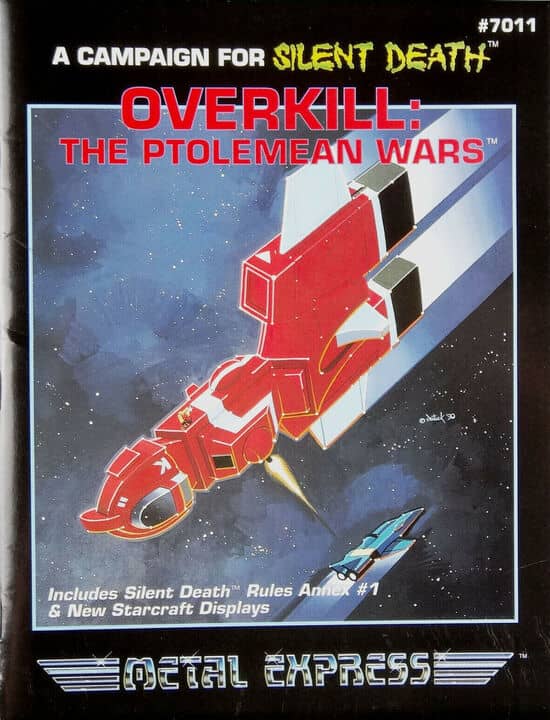 |
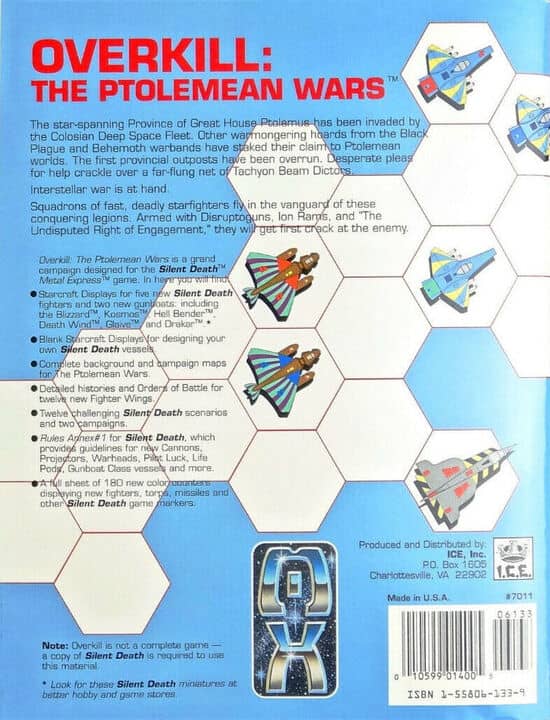 |
Overkill – The Ptolomean Wars (ICE, 1990). Art by David Dietrick
Silent Death is a fast-paced game of small ship-to-ship space combat. The game is specifically designed to be easy to access and play, taking place on a hexagonal grid where each hex represents an abstract section of space.
The original game literally started with a space dogfight. It came with a few pregenerated ships and by the bottom of page 1 of the manual, the hex grid combat board had been set up, pieces had been placed, and you’d started moving about the board. The manual then took you through each subsequent phase and before you knew it you had engaged in battle. By the end of the introductory scenario you had a decent idea how the game worked. Everything thereafter built on this groundwork.
For me this was an innovative and welcome concept. In those days, too many games bogged down in rules and background information that left one frustrated, feeling more like you were studying for an examination than preparing for a bit of fun.
The game concept is simple. You have one or more small fighters. These may be a Single Man Attack Craft (SMAC), Two Man Attack Craft (TMAC) or Multi Man Attack Craft (MMAC). Before anyone panics at the lack of PC naming, please note this was subsequently revised as SPAC, TPAC and MPAC.
Each craft in a player’s squadron has its own spaceship display. These are specific to each ship type and show its value, weaponry, speed, armour, how hard it is to hit and very importantly, its damage track.
On top of this each ship must be assigned a crew: a pilot on a SPAC, a pilot and gunner combination on a TPAC, and so on. Points are spent to buy crew member skills, up to a maximum value of 10. Pretty much all ships allow pilots to shoot, so a pilot requires piloting and gunnery skill, wheres a gunner only requires gunnery. All points spent are added to the ship’s Basic Point Value to obtain a Total Point Value.
Image from Hangar 51 Annex
This becomes important during set-up when you’re deciding what and how to play, as usually both players will agree on the number of points each will have to buy ships and crew. A big part of the strategy begins here. Do you buy a few small ships and crew them with rookies, hoping to overwhelm with numbers, or do you invest in a heavily armoured and armed ship, and crew it with the best money can buy?
Crew skill levels translate into one of the games core concepts, something it shares with Bladestorm – the Attack Dice System. When attacking another ship, only three dice are rolled, always. The key is what dice. One represents the attacker’s Attack Die Bonus (ADB). The higher the gunnery skill, the bigger the die. A gunnery skill of say 3 (out of 10) gets 1D4, whereas a skill of 8 gets 1D8. The other two die in the roll are based on the ships weaponry. Modifiers are added or subtracted for range and number of guns.
Weapons are broken into various categories, such as but not limited to, Laser, Blast and Ion cannons. Lasers are more accurate, so have higher dice in the attack roll, but may do less damage. Blast cannons are less accurate, with lower dice, but when they hit, watch out. The Attack Dice System also dictates the damage dealt, where damage is classified as Low, Medium or High. A weapon that does low damage uses the lowest die score.
By way of example, let us say a pilot fires his Pulse Lasers. Being lasers, they have a higher probability to hit (2D8). The pilot also has a decent gunnery skill and gets a 1D8 ADB. The three dice are rolled and come up 8, 5 and 1, for a total of 16 — a hit. Damage wise, the pulse laser is a lightweight and deals Low damage, thus the target ship is dealt 1-point damage, that being the lowest score on the three dice.
Doubles and triples are added together. From the previous example, let us say the roll was 8, 3 and 3, and the damage dealt suddenly jumps up to 6 (3 + 3). The holy grail of this system thus becomes the triple highest optimum value, which comes back to the core starting strategy — what did you spend on gunnery skill? If say the gunner is weak and has a 1D4 ADB, firing the same pulse lasers, their max possible damage can only be 12 (4 + 4 + 4), where a strong gunner could be looking at 24, enough to obliterate certain ships!
A hit or a miss is based on a simple fixed Defensive Value assigned to each ship. No pilot skill modifiers are applied. If the Attack Dice total is greater than or equal to the target ship’s Defensive Value, a hit is scored. Each ship also has a Damage Reduction (armor) score which reduces damage.
Silent Death firing arcs (SD:TNM Rulebook Page 51)
The last main statistic each ship has is Drive. Simply put, how fast it is. The general rule of thumb is small lights ships with high Drive have a higher Defensive Value, i.e. are harder to hit, but when they are, they take loads of damage due to thin armor. Whereas more heavily armoured ships are slower, with a lower Drive, and easier to hit, but many a hit bounces off due to a higher Damage Reduction.
So why spend points on flying skill? It all comes down to how ships move. A ship expends 1 point of Drive each hex it moves in a straight line. To turn costs 3 points per hex side. Thus, a ship facing 12 o’clock that wishes to move 4 hexes forward and turn clockwise one hex side to face 2 o’clock, will spend 7 Drive points (4 forward + 3 for the turn).
Here comes the next critical concept: the Tight Turn. Say you wish to turn more than one hex side. Let’s say an about face. In the above example, turning from 12 o’clock to 6 o’clock. Using the three points per hex side rule, that will cost 9 points! Silent Death delivers another clever bit of design here, the Tight Turn Cost (TTC). A TTC is deemed any turn more than one hex side and is thus 3 (for the base turn) + a specific die roll. The die rolled is inversely related to a pilot’s skill, where the higher the skill the smaller the dice. A pilot with a low skill, say 1, will have a TTC of 1D10, whereas a skilled pilot with skill of 9 will have a TTC of 1D4.
It follows that about facing with a rookie pilot with a skill of 1 could be disastrous, if a 10 is rolled on 1D10, as the Tight Turn will cost 3 + 10 points. If insufficient Drive points are available the ship simply stops, pointing in the last direction it was facing. From the earlier example, the ship pilot wants to go four hexes forward and then turn to face 4 o’clock. They must expend 4 (forward) + 3 (base turn) + 1d8 (TTC of a pilot with some base skill). Their ship has 11 Drive available, thus to complete the manoeuvre they have to roll 4 or less on 1D8 (11 – 4 – 3). They roll a 5. The tight Turn fails, leaving their ship four hexes from where it started pointing at 12 o’clock.
This movement system is where the strategy comes in. The key is to bring your weapons to bear without becoming exposed. In comes the next concept: a firing arc (see graphic above). Depending on where and how a weapon is mounted it can only be brought to bear across a certain section of hexes. So, say a small SPAC has dual forward facing Splatter Guns, they can only hit targets within the Forward Arc – being hex directly facing, next two, following three, next four and so on. Other arcs are Forward Quadrant Right, Rear Quadrant Right, Rear, Rear Quadrant Left and Forward Quadrant Left.
By using a combination of Drive and pilot skill it become possible to place a ship at the end of its movement in such a way that it can shoot but not be shot at. And now we come to the final important aspect of pilot skill, Initiative. This is a simple roll of 1D10 + pilot skill. The highest result wins. Unlike a traditional RPG where initiative means getting the drop, first strike on an opponent, in Silent Death the initiative winner goes last! Being the last ship to move allows the initiative winner to potentially position their ship in the most favorable location.
This all becomes relevant when you consider the specific sequence of play:
- Warhead Launch Phase
- Movement Phase
- Torp Results Phase
- Cannon Fire Phase
- Missile Results Phase
In a nutshell, everyone moves before everyone fires. Without going into further detail in an already long article, Missiles and Torpedoes round out the system. Ships can carry no warheads, or be verily bristling with deadly items. They can be used to force certain movement behaviours, and deal massive damage if they hit, especially when fired in salvos.
When a hit is scored, it’s time to determine damage. It is possible for a ship to be incapacitated or destroyed by torps before it can use its guns. Similarly, in the cannon fire phase, play is not simultaneous, where gunners shoot before pilots and gunnery skills count, with highest skill going first. Once a hit has been scored and Damage Reduction has been factored, any damage points remaining go through to the ship. Each ship comes with a damage track, represented by a number of blocks. Certain blocks contain specific icons which represent additional damage consequences, such as the loss of Drive or Damage Reduction, Torps or Weapon Systems. Special blocks marked with a starburst require the roll of a critical hit – 2D6 on a Critical Hit table. Once all blocks have been marked off the ship and its crew are destroyed, assuming any critical hits scored on the way to the last block did not knock them out beforehand!
Get in, get the drop, shoot first and take your opponent out before they can shoot back. A universal rule of warfare since the beginning of time. The heavier the ship, the more free blocks it has, but the easier it is to hit, whereas the small light ships tend to vaporise the first time they are hit, if one can hit them at the speed they travel!
Various optional rules are also accommodated to provide additional possibilities, such as inter alia, Asteroids, Side Slips and additional Torpedo Defence Mechanisms, but the core game is highly playable and enjoyable by itself.
One last important mechanic to mention, even though I have pretty much paraphrased a goodly section of the rulebook already, is weapon restrictions. These take the form of range as well as target speed. Range is classified as Short, Medium and Long, with a +1 to hit for short and a -1 for long. Anything beyond long is out of weapon range, meaning it becomes nearly impossible to sit at the opposite end of the map and plink away at your opponent.
Target speed restrictions are another biggie, where generally the big weapons that deal loads of damage are also considerably slower or more cumbersome and as such can only hit targets with a drive less that a specific value. Thus say a Blatgun that does high damage can only hit slower craft with a Drive less than or equal to 13. Trust me, you don’t want to be in a small fast fighter whose drive has been reduced and come up against one of these!
Launched in 1990, Silent Death – Metal Express came in a quality box that contained a 32 page core rulebook, six fold out glossy space hex sheets that equate to a 120 by 107 centimetre game board, a booklet of pregenerated ship displays for the start-up game, color card sheets with punch out ships, asteroids, debris, torps, missiles and other extras, game appropriate dice and lastly 18 quality metal ship miniatures with plastic stands.
Not all ships provided for in the game were included, the expectation being that one would purchase blisters to increase your fleet as you get to know and love the game. If memory serves the ships included were:
- 4 Pit Vipers (SPAC)
- 4 Spirit Riders (SPAC)
- 2 Night Hawks (SPAC)
- 2 Thunder Birds (SPAC)
- 2 Seraph (TPAC)
- 2 Salamander (TPAC)
- 1 Shryak Shuttle (TPAC)
- 1 Epping Gunboat (MPAC)
The rulebook itself is given over to three main sections, being the Rules, Spacecraft Displays for all core ships and a number of Scenarios. No background to the Silent Death universe is provided.
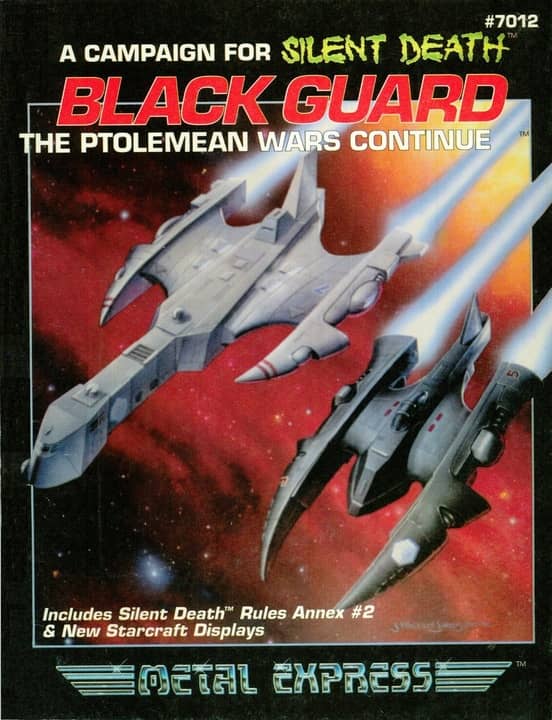 |
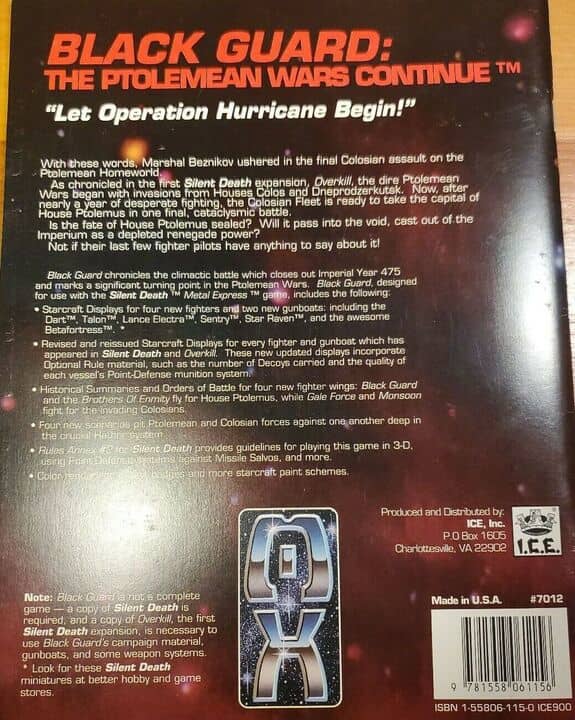 |
Black Guard – The Ptolemean Wars Continue (ICE 1990). Art by J. Wallace Jones
Three supporting expansions were launched with the original game:
Overkill: The Ptolemean Wars was published in 1990. This first expansion detailed a bit about the Silent Death universe, placing the setting officially in the SpaceMaster canon. It details the wars between House Ptolomy and House Colos, along with certain supporting houses, some 9,000 years in Earth’s future. The 52 page expansion included a short history, star systems and basic star charts, details of various fighter units, scenarios and campaigns. Six new ships were detailed as well as a rule expansion that provided a new way to handle gunboats. New weapons and additional optional rules were also added, including a nifty section on designing your own spaceship and went so far as to provide some fighter and gunship display blanks for this purpose. The supplement also came with a punch out card containing additional torpedo and missile markers along with markers for the new ships.
ICE was on a roll in 1990 and before the year was out a second expansion hit the shelves: Black Guard: The Ptolemean Wars Continue. This thinner, 20 page volume did not need to detail the history and setting provided in Overkill. Black Guard got straight to the point, listing some new fighter units, detailing three new fighters and three new gunboats, including what would become the iconic heavy duty ship to beat, the Betafortress. The book included spaceship displays for all ships to date, from the original rules and Overkill as well as more new weapons, additional rules and revised tables.
Two years went by before the next and final instalment of the original game was published: A box set called Night Brood. This introduced aliens into the mix — insectoid beings commonly known as The Grubs. The Night Brood box came with some grub ship miniatures, a 54 page rulebook detailing what the grubs were, their ships and weaponry, and providing numerous scenarios for fighting these weird newcomers and their organic looking ships with names like Larva, Squidge and Muskellunge.
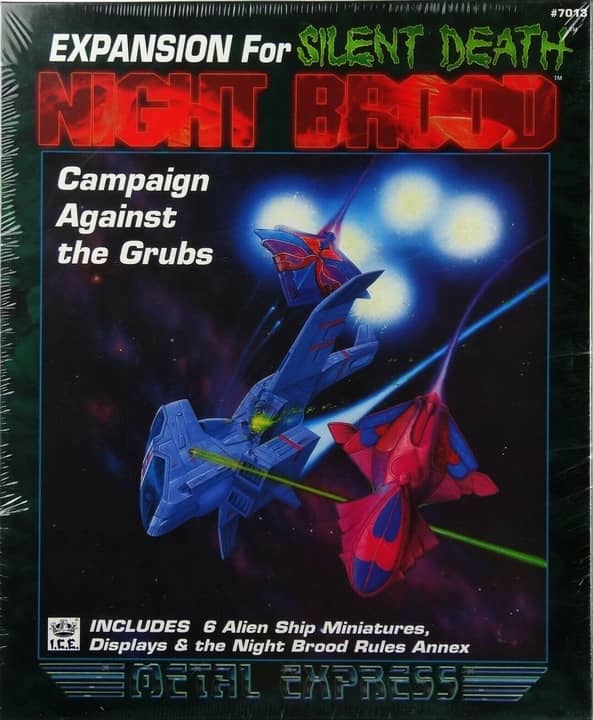 |
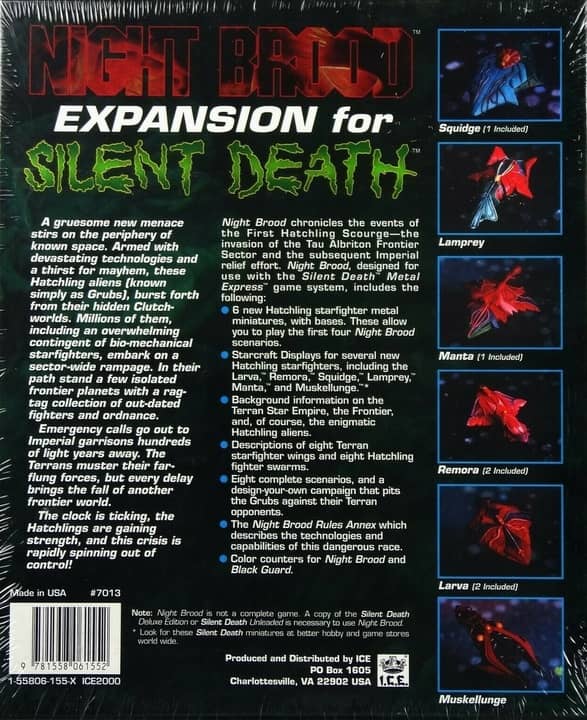 |
Silent Death: Night Brood box set (ICE 1992)
The ICE catalogs of the time contained teasers for upcoming releases, including additional expansions. Alas, Night Brood was the last. A Silent Death – Unleaded version of the game with a thinner box and no miniatures did come out at about the same time as Night Brood, providing a cheaper alternative to attract new players.
By the time Night Brood was in the market, the game designers had recognised a critical issue: game balance. This came down to a few factors, but the key was ship cost. Some ships were simply far too powerful for what they cost. To illustrate this issue:
The entry level ship of the original game was the Pit Viper. A small Light Fighter, a very fast and very fragile SPAC, it cost 9 points. While very effective alone with its low damage pulse lasers, a wing of these working together could be quite lethal, if well played. Then you had the Night Hawk, also a SPAC but considered a Heavy Fighter. Costing 23 points, it mounted an array of splatter guns that would deal medium + 10 damage i.e. minimum 11 points damage guaranteed. Almost as fast as the Pit Viper, with the ability to soak up loads of damage, it was the munchkin on the board.
So for the cost of 43 points max (23 + 10 Pilot + 10 Pilot Gunnery) one could table a lethal ship that was near impossible to get close to without being taken down by its withering barrage. Conversely two Pit Vipers with reasonably skilled crew would cost the same but deliver far less on the board. No matter how good the pilot, sometimes one is simply outclassed and outgunned. I used an extreme example here but there were a number. Certain ships were insanely powerful for what they cost, while others were pretty much unplayable unless all parties agreed on some balancing house rules beforehand.
A secondary issue which was never in my opinion really satisfactorily resolved was scale. Certain SPAC ships were giants next to others that should have been of a similar size. For example, the Night Hawk SPAC’s miniature was one of the biggest ships in the original box, of a similar size to the Epping Gunboat, where it should have been closer in size to its sister ship, the Teal Hawk (available in blister pack only). Another good example was the Pharsii II, a large MPAC which should have been roughly the same size as the Seraph, but came out not much bigger than one of the smallest ships, the Pit Viper.
What to do? The game was a hit, but if the foibles were not addressed it would be doomed to eventual failure. ICE, like The Cylons, had a plan!
Next up: Silent Death: The Next Millennium
Tony Den is an occasional contributor at Black Gate. His coverage until now has concentrated on forgotten or overlooked book series, interspersed with the occasional classic Sci-Fi – often in Ace Double format – retro review. His website RuneQuest.orc has finally had all data moved to Word Press and awaits publication into a production version.
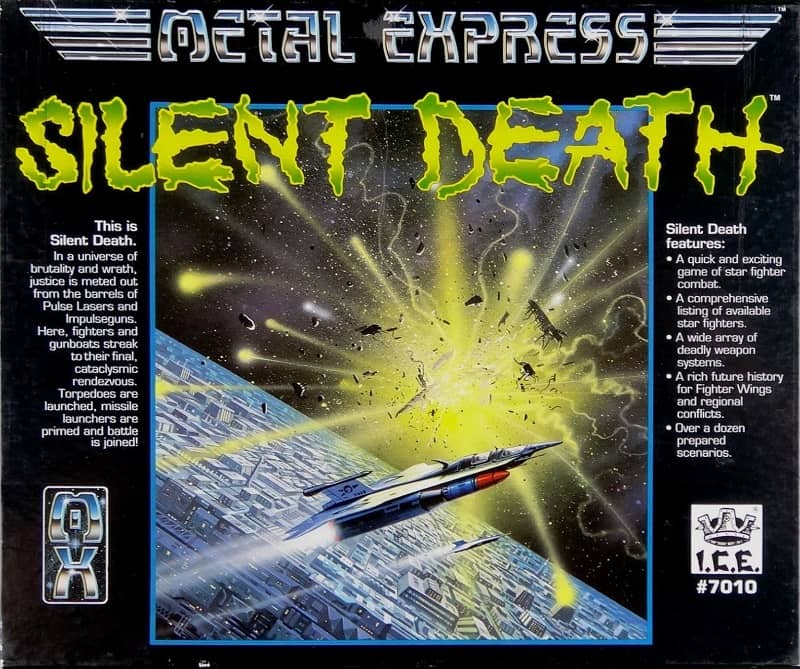

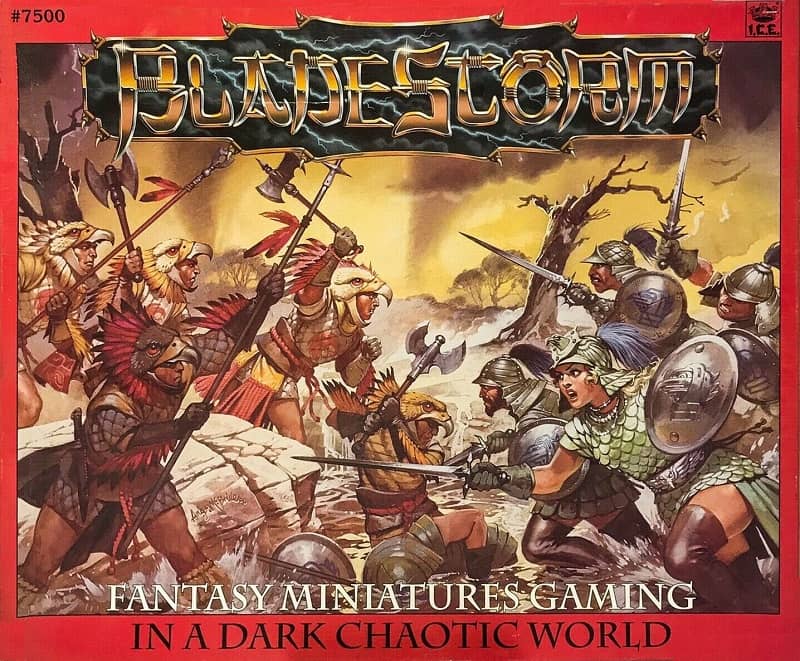
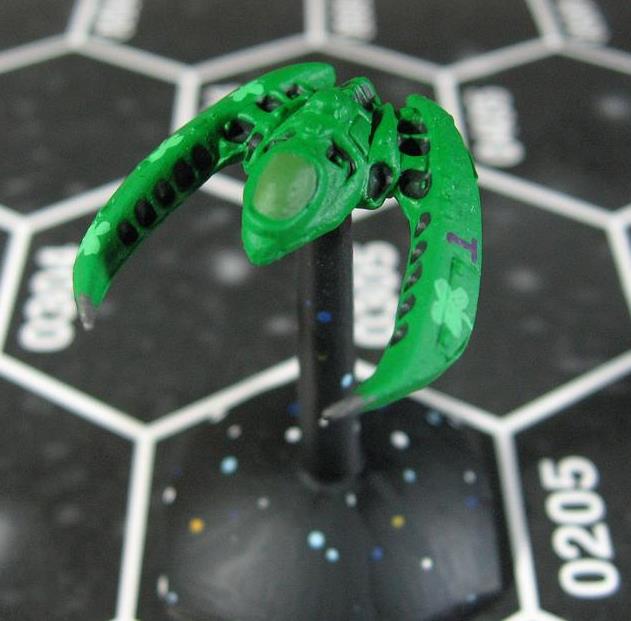
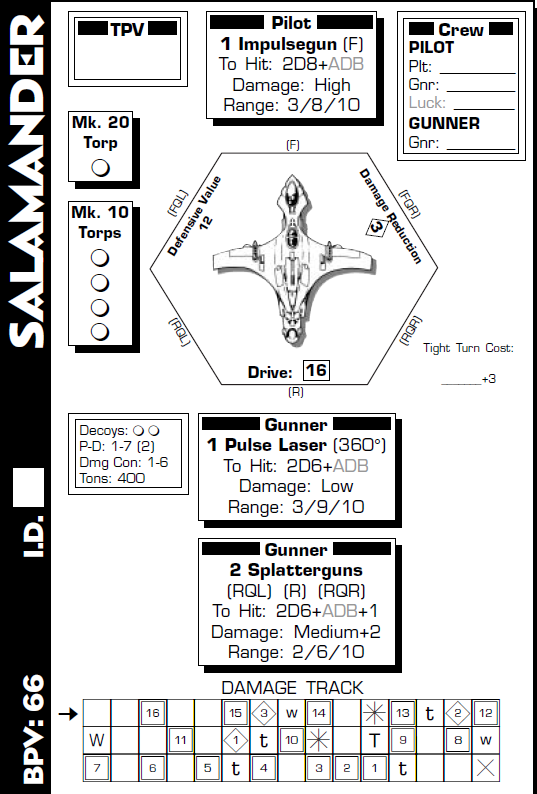
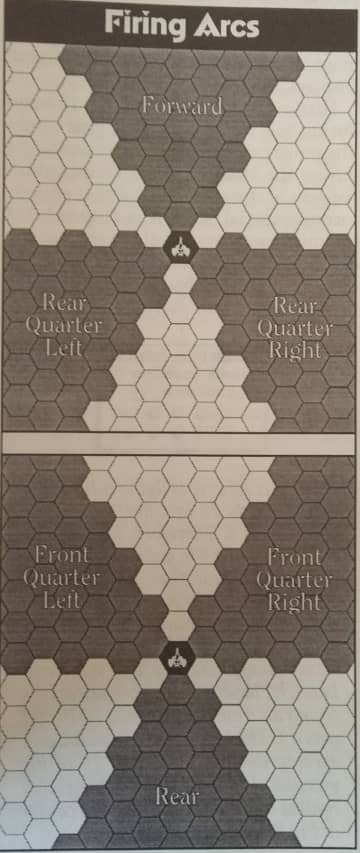

Excellent article! I’m looking forward to the next one!
I’m surprised to see I.C.E. making use of all the “funny dice.” My own introduction into gaming was through I.C.E., first through its strategy Middle-earth board game _The Fellowship of the Ring_ (actually, I don’t remember what that used for resolving situations—I know the counters were teeny-weeny d6s), then MERP and its RM percentile system.
Now that I’m an older and less factional gamer, I embrace the utility of the lowest common denominator to express probabilities. And I’m pleased to see this—and a dice-pool mechanic! how prescient!—in I.CE. I want to look up both _Silent Death_ and _Bladestorm_.
silent death was possibly the best star ship combat game ever. i loved the way they did damage, which i feel like was co[ied by the warmachine people in a sort of way, though there is probly something before silent death that did it that way too.
i am not sure i played this version actually, and only the next millennium one, but man it was a great game. easily broken if you allowed the create a ship rules though.
Gabe Dybing, indeed all the funny dice, bar the icosahedron (d20). Actually as the D12 is used for torpedo damage it gets more use than in many a classic RPG. You can get Silent Death in PDF, so could get a game going really cheap. Loads of fun.
” Star Strike was relatively successful for its time, it was dogged by its heritage. … plenty of gamers found them to be overly complex and rules heavy.”
Yup that pretty much summed up ICE products but the material of Spacemaster was easily adopted for Traveller. The Idorians make a great alternative to the Zhodani in a campaign that doesn’t use psionics or magic
Hah, I painted the “Luck o’ the Irish” Talon pictured in the article. So fun coming up with individual paint schemes.
Really enjoyed my time with Silent Death Next Millenium, and might have a resurgence in my house now that my kids are getting into it. Always felt very adjacent to Battletech – probably the hex maps and record sheets, but I loved the damage track and movement in SD way, way more. Sad it never got a modern (2020s) remake given the love of Star Wars and the extra minis for the Xwing game.
Carlo,
And a fine paint job it is!
I agree that it’s sad that Silent Death never had a modern remake. Especially with the recent success in space miniatures games (I’m thinking chiefly Star Wars and Warhammer 40K). But I always thought Silent Death had a small fan base, and I guess it never got big enough to make a relaunch attractive. But who knows?